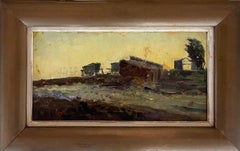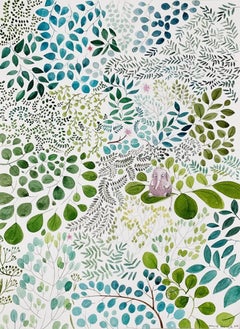Raymond Jean Verdun Art
French, 1873-1954
Raymond Jean Verdun was a pupil of Henri Harpignies. Like Harpignies, he painted trees, giving his landscapes a robust and serene feel. Verdun exhibited at the Salon des Artistes Français in Paris, receiving an honorable mention in 1909.
to
1
1
1
2
1
1
Overall Height
to
Overall Width
to
1
1
1
1
1
2
6,934
3,285
2,514
1,213
1
1
1
1
1
Artist: Raymond Jean Verdun
Cloudy - Original pencil drawing by Raymond Jean Verdun - 1908
By Raymond Jean Verdun
Located in Roma, IT
Cloudy is an original pencil drawing realized by Raymond Jean Verdun (1873 - 1954) in 1908.
Hand-signed and dated by the artist.
Good condition.
Born in 1873 in Nogent-le-Rotrou, Raymond Jean Verdun was a student of Henri Harpignies...
Category
Early 1900s Modern Raymond Jean Verdun Art
Materials
Pencil
“French Countryside at Dusk”
By Raymond Jean Verdun
Located in Southampton, NY
Oil on heavy card stock laid down on masonite by the French artist, Raymond Jean Verdun. Signed lower right. Circa 1895. Condition: Good.
Overall framed 7 by 11 inches. The frame has been restored.
Born 1873, in Nogent-le-Rotrou; died 1954...
Category
1890s Barbizon School Raymond Jean Verdun Art
Materials
Masonite, Paper, Oil
Related Items
Oil Painting 19th Century Cows Landscape Barbizon
By Antonio Cortes
Located in Saint-Ouen, FR
CORTES Antonio (1827-1908)
Cows to pasture
Oil on canvas signed lower left
Old frame gilded with leaves
Dim canvas : 54 X 65 cm
Dim frame: 70 x 86 cm...
Category
1860s Barbizon School Raymond Jean Verdun Art
Materials
Oil
H 27.56 in W 33.86 in D 2.37 in
Who needs a mammoth - Book illustration, Polish artist, Watercolor painting
By Joanna Rusinek
Located in Warsaw, PL
Illustration for book by Agnieszka Frączek 'Who needs a mammoth'
JOANNA RUSINEK
Printmaker, illustrator of children's books, author of press ill...
Category
2010s Contemporary Raymond Jean Verdun Art
Materials
Paper, Watercolor, Pencil
Laundresses on River 19th century Barbizonian Landscape by French Master
Located in Stockholm, SE
Signed lower right "C. Daubigny". As we gaze upon the painting, we are immediately drawn to the foreground, where a small group of women are diligently washing clothes on the banks o...
Category
Mid-19th Century Barbizon School Raymond Jean Verdun Art
Materials
Canvas, Wood, Cotton Canvas, Oil
River Cottage 1849/ Barbizon landscape heralding Impressionism Jongkind's friend
By Henri Sieurac
Located in Norwich, GB
A wonderful view of a river landscape with a rustic cottage and pollarded trees by Henri Sieurac. It isa rare, early and very fresh landscape by this Parisian artist which may well have been painted in the countryside around Barbizon, near the river Loing.
Henry Sieurac had studied with his father, François Joseph Sieurac , and of Paul Delaroche...
Category
1840s Barbizon School Raymond Jean Verdun Art
Materials
Oil, Canvas
H 13.39 in W 16.54 in D 1.19 in
A Winter Wonderland, Barbizon School Snowscape.
Located in Cotignac, FR
An oil on panel view of a winter snow scene by Boggio. The painting is signed bottom right.
A charming view of a snow scene, a river running by a bank heavy with snow.
Category
Mid-20th Century Barbizon School Raymond Jean Verdun Art
Materials
Oil, Board
The Forest, Large Barbizon School, Oil on Canvas Wooded Landscape
By Emile Roux-Fabre
Located in Cotignac, FR
A French Barbizon School oil on canvas forest view by Emile Roux-Fabre. The painting is signed and dated bottom left with a dedication.
A charming view of forest glade leading out to a valley landscape beyond. The artist has captured the magic feeling of the cool forest shade against the sunshine of the landscape beyond. The texture of the bark on the silver birch trees, the contrast of the leaves on the trees all framing the perspective to the view beyond. An extremely accomplished and atmospheric painting.
The Barbizon school of painters was part of an art movement towards Realism in art, which arose in the context of the dominant Romantic Movement of the time. The Barbizon school was active roughly from 1830 through 1870. It takes its name from the village of Barbizon, France, on the edge of the Forest of Fontainebleau, where many of the artists gathered. Most of their works were landscape paintings, but several of them also painted landscapes with farmworkers, and genre scenes of village life. Some of the most prominent features of this school are its tonal qualities, colour, loose brushwork, and softness of form.
The leaders of the Barbizon school were: Théodore Rousseau, Charles-François Daubigny, Jules Dupré, Constant Troyon, Charles Jacque, and Narcisse Virgilio Díaz. Jean-François Millet lived in Barbizon from 1849, but his interest in figures with a landscape backdrop sets him rather apart from the others. Jean-Baptiste-Camille Corot was the earliest on the scene, first painting in the forest in 1829, but his work has a poetic and literary quality which sets him somewhat apart. Other artists associated with the school, often pupils of the main group, include: Henri Harpignies, Albert Charpin, François-Louis Français and Émile van Marcke.
In 1824 the Salon de Paris exhibited works of John Constable, an English painter. His rural scenes influenced some of the younger artists of the time, moving them to abandon formalism and to draw inspiration directly from nature. Natural scenes became the subjects of their paintings rather than mere backdrops to dramatic events. During the Revolutions of 1848 artists gathered at Barbizon to follow Constable's ideas, making nature the subject of their paintings. The French landscape became a major theme of the Barbizon painters.
Millet extended the idea from landscape to figures — peasant figures, scenes of peasant life, and work in the fields. In The Gleaners (1857), for example, Millet portrays three peasant women working at the harvest. Gleaners are poor people who are permitted to gather the remains after the owners of the field complete the main harvest. The owners (portrayed as wealthy) and their laborers are seen in the back of the painting. Millet shifted the focus and the subject matter from the rich and prominent to those at the bottom of the social ladders. To emphasize their anonymity and marginalized position, he hid their faces. The women's bowed bodies represent their everyday hard work.
In the spring of 1829, Jean-Baptiste-Camille Corot came to Barbizon to paint in the Forest of Fontainebleau, he had first painted in the forest at Chailly in 1822. He returned to Barbizon in the autumn of 1830 and in the summer of 1831, where he made drawings and oil studies, from which he made a painting intended for the Salon of 1830; "View of the Forest of Fontainebleau'" (now in the National Gallery in Washington) and, for the salon of 1831, another "View of the Forest of Fontainebleau"'. While there he met the members of the Barbizon school: Théodore Rousseau, Paul Huet, Constant Troyon, Jean-François Millet, and the young Charles-François Daubigny.
During the late 1860s, the Barbizon painters attracted the attention of a younger generation of French artists studying in Paris. Several of those artists visited Fontainebleau Forest to paint the landscape, including Claude Monet, Pierre-Auguste Renoir, Alfred Sisley and Frédéric Bazille. In the 1870s those artists, among others, developed the art movement called Impressionism and practiced 'plein air' painting. In contrast, the main members of the school made drawings and sketches on the spot, but painted back in their studios.
The Post-Impressionist painter Vincent Van Gogh studied and copied several of the Barbizon painters as well, including 21 copies of paintings by Millet. He copied Millet more than any other artist. He also did three paintings in Daubigny's Garden.
The Barbizon painters also had a profound impact on landscape painting in the United States. This included the development of the American Barbizon school by William Morris Hunt. Several artists who were also in, or contemporary to, the Hudson River School studied Barbizon paintings for their loose brushwork and emotional impact. A notable example is George Inness, who sought to emulate the works of Rousseau. Paintings from the Barbizon school also influenced landscape painting in California. The artist Percy Gray...
Category
Early 20th Century Barbizon School Raymond Jean Verdun Art
Materials
Canvas, Oil
H 24.02 in W 20.08 in D 0.79 in
Corot student Barbizon landscape with Figure French 19th Century oil painting
Located in Norwich, GB
A wonderful rural scene of a woman walking at sunset in a wide landscape, imbued with almost magical light. It is a work by French artist Pierre-Ernest Ballue, who had studied painti...
Category
Late 19th Century Barbizon School Raymond Jean Verdun Art
Materials
Oil, Wood
H 25.99 in W 3.94 in D 18.51 in
The Marshlands
Located in Storrs, CT
A marsh landscape in the style of Max Weyl. Oil on board measures 12 3/4 x 23 5/8; frame dimensions measure 16 1/4 x 27 x 1 1/4. Unsigned. Housed in a gold-to...
Category
20th Century Barbizon School Raymond Jean Verdun Art
Materials
Oil
"Manhattan Bridge" NYC American Scene Modernism Watercolor WPA Urban Realism
By Reginald Marsh
Located in New York, NY
Reginald Marsh "Manhattan Bridge" NYC American Scene Modernism Watercolor WPA Urban Realism, 20 x 14 inches. Watercolor and pencil on paper, 1938. Signed...
Category
1930s American Modern Raymond Jean Verdun Art
Materials
Paper, Watercolor, Pencil
The Archibald Russell.
By Arthur John Trevor Briscoe
Located in Storrs, CT
The Archibald Russell. 1935. Pencil and watercolour on watercolour board. 20 7/8 x 28 5/8. Mat line from a previous mount; otherwise excellent condition. Signed and dated in ink, low...
Category
1930s Modern Raymond Jean Verdun Art
Materials
Watercolor, Pencil
Disappearances / Extinctions #1 Hélène Duclos 21st Century drawing landscape art
By Hélène Duclos
Located in Paris, FR
This drawing is part of the current exhibition entitled "The fantastic story of the liquid mountain" at Claire Corcia Gallery in Paris.
The liquid mountain is populated by living be...
Category
2010s Contemporary Raymond Jean Verdun Art
Materials
Color Pencil, Graphite, Paper, Gouache
H 39.38 in W 27.56 in D 1.97 in
The Ones that Got Away - Two Pointer Dogs by a River
By Eugène Petit
Located in St. Albans, GB
Eugene Petit 1839 - 1886
Oil on canvas
Painting Size: 18 x 21 3/4" (46 x 56cm)
Outside Frame Size: 25 x 28 3/4" (63 x 73cm)
Free Shipping
He was born in 1839 at Paris and died in...
Category
Late 19th Century Barbizon School Raymond Jean Verdun Art
Materials
Oil
Raymond Jean Verdun art for sale on 1stDibs.
Find a wide variety of authentic Raymond Jean Verdun art available for sale on 1stDibs. You can also browse by medium to find art by Raymond Jean Verdun in masonite, oil paint, paint and more. Much of the original work by this artist or collective was created during the early 1900s and is mostly associated with the modern style. Not every interior allows for large Raymond Jean Verdun art, so small editions measuring 9 inches across are available. Customers who are interested in this artist might also find the work of Jean François Millet, Henri Joseph Harpignies, and Alfred East. Raymond Jean Verdun art prices can differ depending upon medium, time period and other attributes. On 1stDibs, the price for these items starts at $78 and tops out at $3,200, while the average work can sell for $1,639.



